Hong Liu
School of Electrical and Computer Engineering, University of Oklahoma, Norman, OK, USA
HDCNet: A Hybrid Depth Completion Network for Grasping Transparent and Reflective Objects
Nov 10, 2025Abstract:Depth perception of transparent and reflective objects has long been a critical challenge in robotic manipulation.Conventional depth sensors often fail to provide reliable measurements on such surfaces, limiting the performance of robots in perception and grasping tasks. To address this issue, we propose a novel depth completion network,HDCNet,which integrates the complementary strengths of Transformer,CNN and Mamba architectures.Specifically,the encoder is designed as a dual-branch Transformer-CNN framework to extract modality-specific features. At the shallow layers of the encoder, we introduce a lightweight multimodal fusion module to effectively integrate low-level features. At the network bottleneck,a Transformer-Mamba hybrid fusion module is developed to achieve deep integration of high-level semantic and global contextual information, significantly enhancing depth completion accuracy and robustness. Extensive evaluations on multiple public datasets demonstrate that HDCNet achieves state-of-the-art(SOTA) performance in depth completion tasks.Furthermore,robotic grasping experiments show that HDCNet substantially improves grasp success rates for transparent and reflective objects,achieving up to a 60% increase.
Every Step Evolves: Scaling Reinforcement Learning for Trillion-Scale Thinking Model
Oct 21, 2025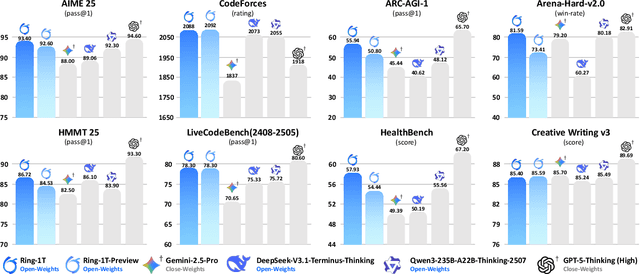
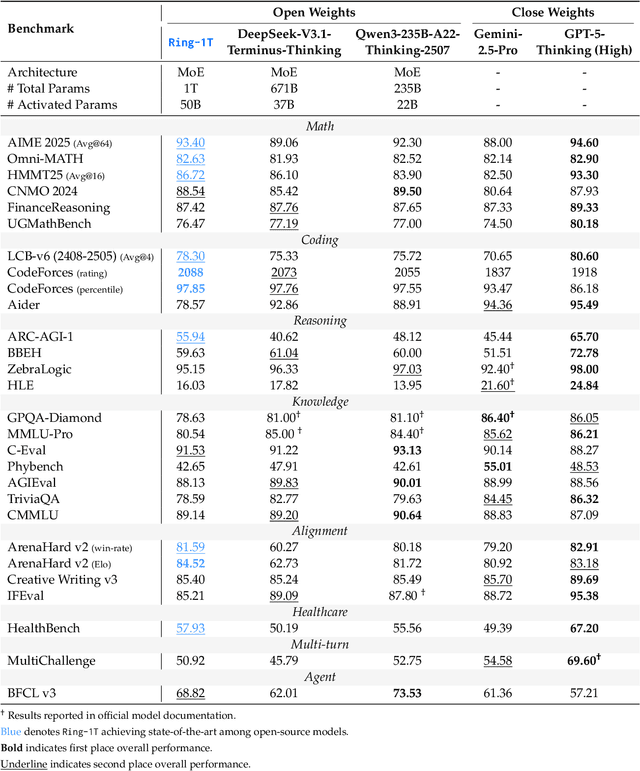
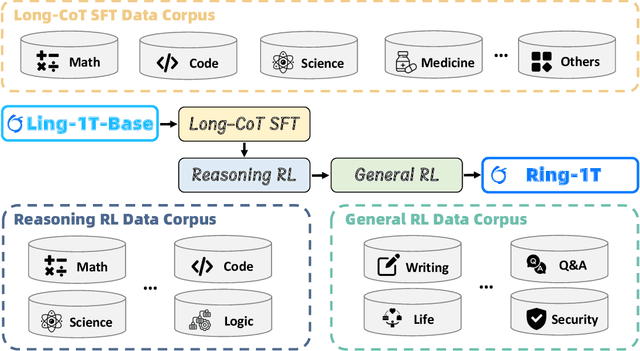
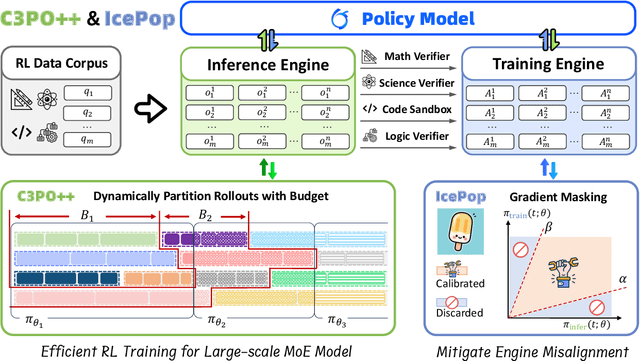
Abstract:We present Ring-1T, the first open-source, state-of-the-art thinking model with a trillion-scale parameter. It features 1 trillion total parameters and activates approximately 50 billion per token. Training such models at a trillion-parameter scale introduces unprecedented challenges, including train-inference misalignment, inefficiencies in rollout processing, and bottlenecks in the RL system. To address these, we pioneer three interconnected innovations: (1) IcePop stabilizes RL training via token-level discrepancy masking and clipping, resolving instability from training-inference mismatches; (2) C3PO++ improves resource utilization for long rollouts under a token budget by dynamically partitioning them, thereby obtaining high time efficiency; and (3) ASystem, a high-performance RL framework designed to overcome the systemic bottlenecks that impede trillion-parameter model training. Ring-1T delivers breakthrough results across critical benchmarks: 93.4 on AIME-2025, 86.72 on HMMT-2025, 2088 on CodeForces, and 55.94 on ARC-AGI-v1. Notably, it attains a silver medal-level result on the IMO-2025, underscoring its exceptional reasoning capabilities. By releasing the complete 1T parameter MoE model to the community, we provide the research community with direct access to cutting-edge reasoning capabilities. This contribution marks a significant milestone in democratizing large-scale reasoning intelligence and establishes a new baseline for open-source model performance.
PANICL: Mitigating Over-Reliance on Single Prompt in Visual In-Context Learning
Sep 26, 2025Abstract:Visual In-Context Learning (VICL) uses input-output image pairs, referred to as in-context pairs (or examples), as prompts alongside query images to guide models in performing diverse vision tasks. However, VICL often suffers from over-reliance on a single in-context pair, which can lead to biased and unstable predictions. We introduce PAtch-based $k$-Nearest neighbor visual In-Context Learning (PANICL), a general training-free framework that mitigates this issue by leveraging multiple in-context pairs. PANICL smooths assignment scores across pairs, reducing bias without requiring additional training. Extensive experiments on a variety of tasks, including foreground segmentation, single object detection, colorization, multi-object segmentation, and keypoint detection, demonstrate consistent improvements over strong baselines. Moreover, PANICL exhibits strong robustness to domain shifts, including dataset-level shift (e.g., from COCO to Pascal) and label-space shift (e.g., FSS-1000), and generalizes well to other VICL models such as SegGPT, Painter, and LVM, highlighting its versatility and broad applicability.
Enhancing WSI-Based Survival Analysis with Report-Auxiliary Self-Distillation
Sep 19, 2025Abstract:Survival analysis based on Whole Slide Images (WSIs) is crucial for evaluating cancer prognosis, as they offer detailed microscopic information essential for predicting patient outcomes. However, traditional WSI-based survival analysis usually faces noisy features and limited data accessibility, hindering their ability to capture critical prognostic features effectively. Although pathology reports provide rich patient-specific information that could assist analysis, their potential to enhance WSI-based survival analysis remains largely unexplored. To this end, this paper proposes a novel Report-auxiliary self-distillation (Rasa) framework for WSI-based survival analysis. First, advanced large language models (LLMs) are utilized to extract fine-grained, WSI-relevant textual descriptions from original noisy pathology reports via a carefully designed task prompt. Next, a self-distillation-based pipeline is designed to filter out irrelevant or redundant WSI features for the student model under the guidance of the teacher model's textual knowledge. Finally, a risk-aware mix-up strategy is incorporated during the training of the student model to enhance both the quantity and diversity of the training data. Extensive experiments carried out on our collected data (CRC) and public data (TCGA-BRCA) demonstrate the superior effectiveness of Rasa against state-of-the-art methods. Our code is available at https://github.com/zhengwang9/Rasa.
Synthetic bootstrapped pretraining
Sep 17, 2025Abstract:We introduce Synthetic Bootstrapped Pretraining (SBP), a language model (LM) pretraining procedure that first learns a model of relations between documents from the pretraining dataset and then leverages it to synthesize a vast new corpus for joint training. While the standard pretraining teaches LMs to learn causal correlations among tokens within a single document, it is not designed to efficiently model the rich, learnable inter-document correlations that can potentially lead to better performance. We validate SBP by designing a compute-matched pretraining setup and pretrain a 3B-parameter model on up to 1T tokens from scratch. We find SBP consistently improves upon a strong repetition baseline and delivers a significant fraction of performance improvement attainable by an oracle upper bound with access to 20x more unique data. Qualitative analysis reveals that the synthesized documents go beyond mere paraphrases -- SBP first abstracts a core concept from the seed material and then crafts a new narration on top of it. Besides strong empirical performance, SBP admits a natural Bayesian interpretation: the synthesizer implicitly learns to abstract the latent concepts shared between related documents.
MAESTRO: Multi-modal Adaptive Ensemble for Spectro-Temporal Robust Optimization
Sep 10, 2025Abstract:Timely and robust influenza incidence forecasting is critical for public health decision-making. To address this, we present MAESTRO, a Multi-modal Adaptive Ensemble for Spectro-Temporal Robust Optimization. MAESTRO achieves robustness by adaptively fusing multi-modal inputs-including surveillance, web search trends, and meteorological data-and leveraging a comprehensive spectro-temporal architecture. The model first decomposes time series into seasonal and trend components. These are then processed through a hybrid feature enhancement pipeline combining Transformer-based encoders, a Mamba state-space model for long-range dependencies, multi-scale temporal convolutions, and a frequency-domain analysis module. A cross-channel attention mechanism further integrates information across the different data modalities. Finally, a temporal projection head performs sequence-to-sequence forecasting, with an optional estimator to quantify prediction uncertainty. Evaluated on over 11 years of Hong Kong influenza data (excluding the COVID-19 period), MAESTRO shows strong competitive performance, demonstrating a superior model fit and relative accuracy, achieving a state-of-the-art R-square of 0.956. Extensive ablations confirm the significant contributions of both multi-modal fusion and the spectro-temporal components. Our modular and reproducible pipeline is made publicly available to facilitate deployment and extension to other regions and pathogens.Our publicly available pipeline presents a powerful, unified framework, demonstrating the critical synergy of advanced spectro-temporal modeling and multi-modal data fusion for robust epidemiological forecasting.
H$_{2}$OT: Hierarchical Hourglass Tokenizer for Efficient Video Pose Transformers
Sep 08, 2025



Abstract:Transformers have been successfully applied in the field of video-based 3D human pose estimation. However, the high computational costs of these video pose transformers (VPTs) make them impractical on resource-constrained devices. In this paper, we present a hierarchical plug-and-play pruning-and-recovering framework, called Hierarchical Hourglass Tokenizer (H$_{2}$OT), for efficient transformer-based 3D human pose estimation from videos. H$_{2}$OT begins with progressively pruning pose tokens of redundant frames and ends with recovering full-length sequences, resulting in a few pose tokens in the intermediate transformer blocks and thus improving the model efficiency. It works with two key modules, namely, a Token Pruning Module (TPM) and a Token Recovering Module (TRM). TPM dynamically selects a few representative tokens to eliminate the redundancy of video frames, while TRM restores the detailed spatio-temporal information based on the selected tokens, thereby expanding the network output to the original full-length temporal resolution for fast inference. Our method is general-purpose: it can be easily incorporated into common VPT models on both seq2seq and seq2frame pipelines while effectively accommodating different token pruning and recovery strategies. In addition, our H$_{2}$OT reveals that maintaining the full pose sequence is unnecessary, and a few pose tokens of representative frames can achieve both high efficiency and estimation accuracy. Extensive experiments on multiple benchmark datasets demonstrate both the effectiveness and efficiency of the proposed method. Code and models are available at https://github.com/NationalGAILab/HoT.
UST-SSM: Unified Spatio-Temporal State Space Models for Point Cloud Video Modeling
Aug 20, 2025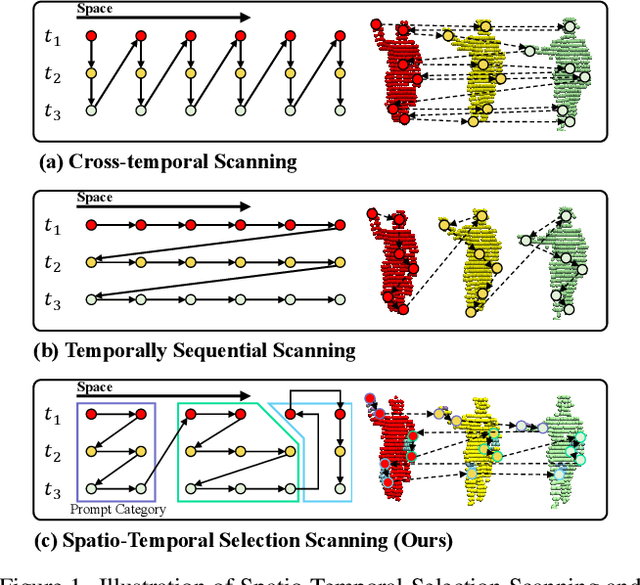
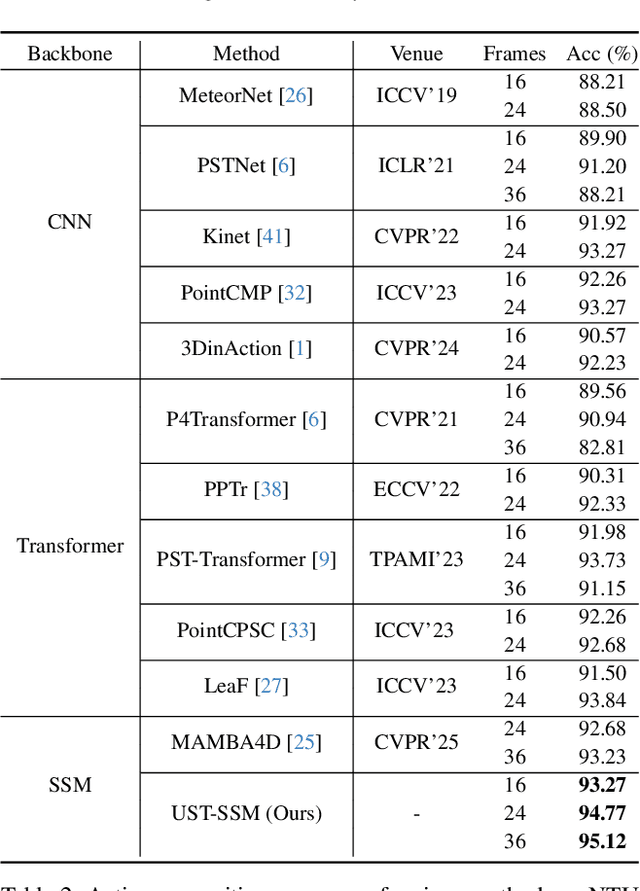
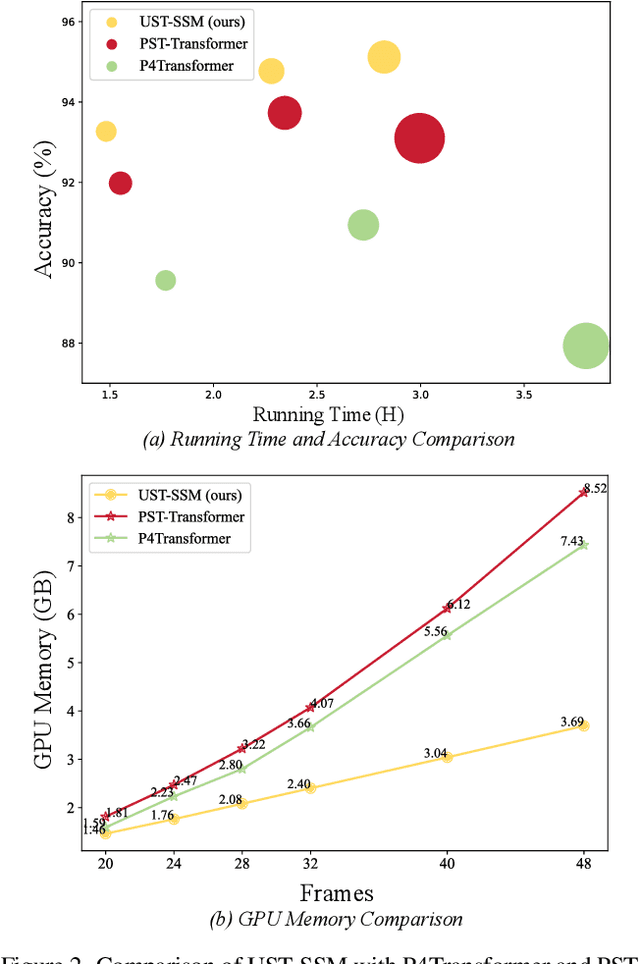
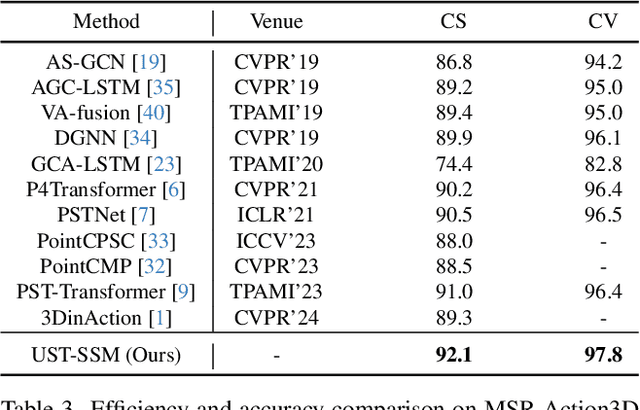
Abstract:Point cloud videos capture dynamic 3D motion while reducing the effects of lighting and viewpoint variations, making them highly effective for recognizing subtle and continuous human actions. Although Selective State Space Models (SSMs) have shown good performance in sequence modeling with linear complexity, the spatio-temporal disorder of point cloud videos hinders their unidirectional modeling when directly unfolding the point cloud video into a 1D sequence through temporally sequential scanning. To address this challenge, we propose the Unified Spatio-Temporal State Space Model (UST-SSM), which extends the latest advancements in SSMs to point cloud videos. Specifically, we introduce Spatial-Temporal Selection Scanning (STSS), which reorganizes unordered points into semantic-aware sequences through prompt-guided clustering, thereby enabling the effective utilization of points that are spatially and temporally distant yet similar within the sequence. For missing 4D geometric and motion details, Spatio-Temporal Structure Aggregation (STSA) aggregates spatio-temporal features and compensates. To improve temporal interaction within the sampled sequence, Temporal Interaction Sampling (TIS) enhances fine-grained temporal dependencies through non-anchor frame utilization and expanded receptive fields. Experimental results on the MSR-Action3D, NTU RGB+D, and Synthia 4D datasets validate the effectiveness of our method. Our code is available at https://github.com/wangzy01/UST-SSM.
Masked Clustering Prediction for Unsupervised Point Cloud Pre-training
Aug 12, 2025



Abstract:Vision transformers (ViTs) have recently been widely applied to 3D point cloud understanding, with masked autoencoding as the predominant pre-training paradigm. However, the challenge of learning dense and informative semantic features from point clouds via standard ViTs remains underexplored. We propose MaskClu, a novel unsupervised pre-training method for ViTs on 3D point clouds that integrates masked point modeling with clustering-based learning. MaskClu is designed to reconstruct both cluster assignments and cluster centers from masked point clouds, thus encouraging the model to capture dense semantic information. Additionally, we introduce a global contrastive learning mechanism that enhances instance-level feature learning by contrasting different masked views of the same point cloud. By jointly optimizing these complementary objectives, i.e., dense semantic reconstruction, and instance-level contrastive learning. MaskClu enables ViTs to learn richer and more semantically meaningful representations from 3D point clouds. We validate the effectiveness of our method via multiple 3D tasks, including part segmentation, semantic segmentation, object detection, and classification, where MaskClu sets new competitive results. The code and models will be released at:https://github.com/Amazingren/maskclu.
Recognizing Actions from Robotic View for Natural Human-Robot Interaction
Jul 30, 2025



Abstract:Natural Human-Robot Interaction (N-HRI) requires robots to recognize human actions at varying distances and states, regardless of whether the robot itself is in motion or stationary. This setup is more flexible and practical than conventional human action recognition tasks. However, existing benchmarks designed for traditional action recognition fail to address the unique complexities in N-HRI due to limited data, modalities, task categories, and diversity of subjects and environments. To address these challenges, we introduce ACTIVE (Action from Robotic View), a large-scale dataset tailored specifically for perception-centric robotic views prevalent in mobile service robots. ACTIVE comprises 30 composite action categories, 80 participants, and 46,868 annotated video instances, covering both RGB and point cloud modalities. Participants performed various human actions in diverse environments at distances ranging from 3m to 50m, while the camera platform was also mobile, simulating real-world scenarios of robot perception with varying camera heights due to uneven ground. This comprehensive and challenging benchmark aims to advance action and attribute recognition research in N-HRI. Furthermore, we propose ACTIVE-PC, a method that accurately perceives human actions at long distances using Multilevel Neighborhood Sampling, Layered Recognizers, Elastic Ellipse Query, and precise decoupling of kinematic interference from human actions. Experimental results demonstrate the effectiveness of ACTIVE-PC. Our code is available at: https://github.com/wangzy01/ACTIVE-Action-from-Robotic-View.
 Add to Chrome
Add to Chrome Add to Firefox
Add to Firefox Add to Edge
Add to Edge